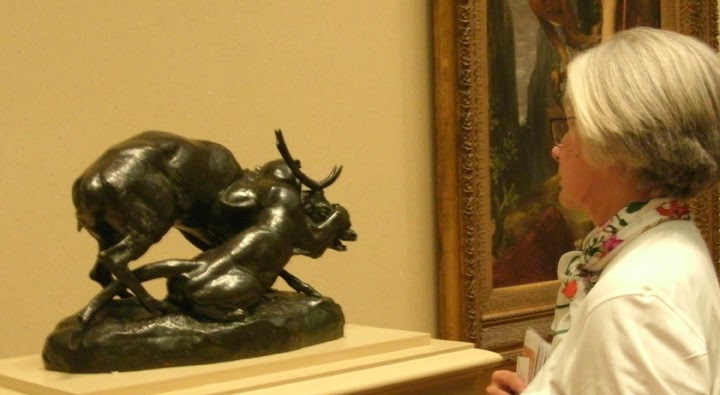Please see the previous blog for more information about this post.

The Jardin de Plantes in Paris which includes the menagerie (zoo) expanded dramatically
in the early years of the 19th century and the definitive sculptor of animals,
Antoine-Louis Barye was a frequent visitor. Throughout his life it was a source of
reference and inspiration and provided the basis for his scientific approach to sculpture.
At various times, the menagerie had exotic animals such as Asian elephants and lions. When the animals died, he would attend their dissections, make a multitude of drawings
and spend hours taking measurements and recording detailed proportions.
He put his years of self-study at the zoo and his knowledge of anatomy to good use . . . emphasizing the musculature of animals in a bold and energetic manner.
His idealized, stylized, and dramatized sculptures of animals are without equal.
Below, is an image of Barye's sculpture taken in the menagerie
at the Jardin des Plantes in Paris last month.
at the Jardin des Plantes in Paris last month.
While exploring the menagerie and experiencing the animals, I was consumed
with the realization that Barye, his good friend, Delacroix, and many other great artists
such as Bugatti and Fremiet, walked the same paths and trails in years past.
Below, are images.
Below, I'm concluding every blog about our trip to Paris last month with a glimpse of life in the beautiful city.
Christmas time in Paris is magic! One sunny morning, Trish and I walked from the Place Concord
along the Champs Elysees to the Petit Palace Museum. After our museum visit,
we continued to the Arc Triomphe then back to the Tuileries.
The Champs Elysees is lined on both sides with kiosks and outdoor kitchens serving every food and drink imaginable.
We enjoyed a hot wine and a raclette, which is a sandwich served by warming the top of a large cheese wheel
with a heating device then scraping the melted cheese onto a baguette with ham and optional potatoes.
The long walk back to the metro was welcome after a late lunch!
with the realization that Barye, his good friend, Delacroix, and many other great artists
such as Bugatti and Fremiet, walked the same paths and trails in years past.
Below, are images.
Below, I'm concluding every blog about our trip to Paris last month with a glimpse of life in the beautiful city.
Christmas time in Paris is magic! One sunny morning, Trish and I walked from the Place Concord
along the Champs Elysees to the Petit Palace Museum. After our museum visit,
we continued to the Arc Triomphe then back to the Tuileries.
The Champs Elysees is lined on both sides with kiosks and outdoor kitchens serving every food and drink imaginable.
We enjoyed a hot wine and a raclette, which is a sandwich served by warming the top of a large cheese wheel
with a heating device then scraping the melted cheese onto a baguette with ham and optional potatoes.
The long walk back to the metro was welcome after a late lunch!
Go to the BLOG INDEX on the right for more information.
Blog, text, photos, drawings, and sculpture . . . © Sandy Scott and Trish














































